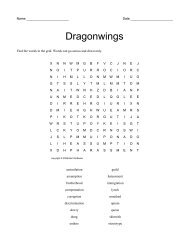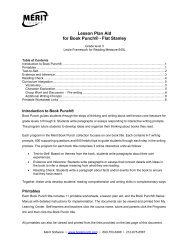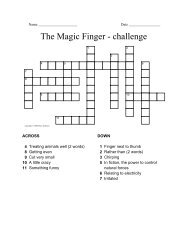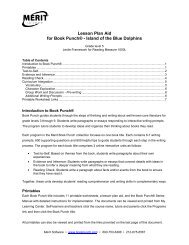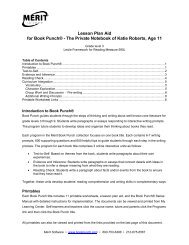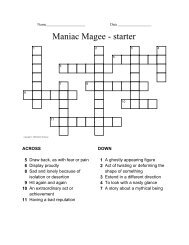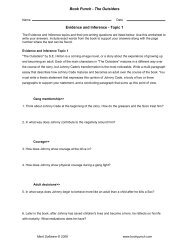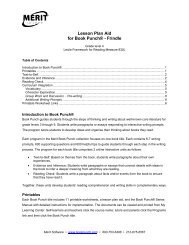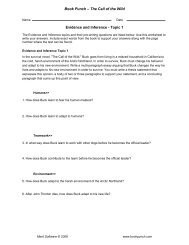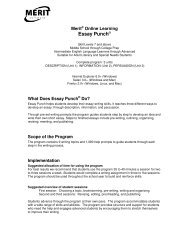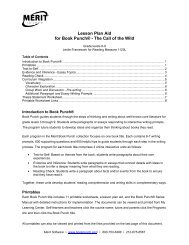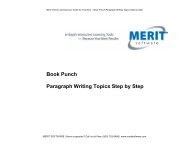Why Use Business Letter Punch? - Merit Software
Why Use Business Letter Punch? - Merit Software
Why Use Business Letter Punch? - Merit Software
You also want an ePaper? Increase the reach of your titles
YUMPU automatically turns print PDFs into web optimized ePapers that Google loves.
<strong>Punch</strong><strong>Software</strong> for teachingwriting and reading.<strong>Business</strong> <strong>Letter</strong> <strong>Punch</strong> ManualSkill Levels 6-10Complete program: 4 unitsPERSUASION (Unit 1),REQUEST (Unit 2),COMPLAINT/RESPONSE (Unit 3),SOCIAL BUSINESS (Unit 4)Evaluation version: <strong>Letter</strong> of REQUEST (Unit 2)Tracks work for two students.Internet Explorer 6.0+ on WindowsFirefox 0.8+ on Windows and LinuxSafari 1.2.4+ on MacBest viewed at 1024 x 768 screen resolution.Table of Contents<strong>Why</strong> <strong>Use</strong> <strong>Business</strong> <strong>Letter</strong> <strong>Punch</strong>?................................................................................................... 2Benefits of Using <strong>Business</strong> <strong>Letter</strong> <strong>Punch</strong>..................................................................................... 2What Does <strong>Business</strong> <strong>Letter</strong> <strong>Punch</strong> Do? .......................................................................................... 2The <strong>Business</strong> <strong>Letter</strong> <strong>Punch</strong> Method............................................................................................. 2Scope of the Program: Skills ........................................................................................................... 3Implementation ................................................................................................................................ 3Plan of Action for Using the Program Integrated with the Curriculum ......................................... 3Class Time – Preparing Your Students to <strong>Use</strong> the <strong>Punch</strong> Program ............................................... 3Classroom Curriculum Integration................................................................................................... 4Beyond the Program........................................................................................................................ 5Teacher Orientation to Program Structure or “Anatomy of the Program” ....................................... 6Logging on, Class Management and Course Administration ...................................................... 6<strong>Business</strong> <strong>Letter</strong> <strong>Punch</strong> Step by Step ........................................................................................... 6Administrative Tools ........................................................................................................................ 7Tracking Students’ Work.............................................................................................................. 7Course Management ................................................................................................................... 7Content of <strong>Business</strong> <strong>Letter</strong> <strong>Punch</strong>................................................................................................... 8<strong>Merit</strong> Writing Assessment.............................................................................................................. 10Brainstorming................................................................................................................................. 11Independent Follow-up Worksheet................................................................................................ 12<strong>Merit</strong> <strong>Software</strong> • www.meritsoftware.com • 800-753-6488 • 212-675-8567
<strong>Business</strong> <strong>Letter</strong> <strong>Punch</strong> Manual page 2 of 2<strong>Why</strong> <strong>Use</strong> <strong>Business</strong> <strong>Letter</strong> <strong>Punch</strong>?Benefits of Using <strong>Business</strong> <strong>Letter</strong> <strong>Punch</strong>1. Effective, research-proven computer-assisted instruction: embedded cognitive strategies,e.g., repetition; rehearsal of content; paraphrasing; drawing inferences; use of illustrativeexamples2. Student control over amount and sequence of work performed and extent of review needed,leading to increased mastery and improved attitude towards learning3. Improvement of writing skillsa. Recognition of points of difficulty and confusionb. Advancement at student’s own pacec. Scaffolding and enhancing comprehension4. Generalization of skills to other contexts and situations, i.e., transferring these skills to otheracademic areas5. Appropriate for students of all skill levelsa. Effectiveness seen notably in low-achieving studentsb. Improvement in proficiency among students in middle quartilesc. Enrichment for students in upper quartile6. Detailed class management via <strong>Merit</strong> <strong>Software</strong> record keepera. Teacher can track and check students’ progressb. Teacher can track and intervene at points of difficultyc. Student records may be exported into spread-sheetsWhat Does <strong>Business</strong> <strong>Letter</strong> <strong>Punch</strong> Do?The <strong>Business</strong> <strong>Letter</strong> <strong>Punch</strong> Method1. Engages cognitive thinking and metacognitive strategies step by step2. Supports constructivist learning by providing students with choices; decisions; multiplecompletionpaths for writing tasks3. Strengthens students’ abilities to interpret language-based conceptsa. Focuses instruction at sentence and paragraph levelb. Fosters analysis and discrimination among response options4. Provides a structure that students of all levels can use again and again to improve their skills5. Improves comprehension of students struggling with language arts skills and produces gainsacross the curriculum in social studies, science and mathematics6. Effectively provides a multi-sensory approach7. Teaches different ways to write a paragraph8. Shapes further learning responses through interactive feedback<strong>Merit</strong> <strong>Software</strong> • www.meritsoftware.com • 800-753-6488 • 212-675-8567
Scope of the Program: Skills<strong>Business</strong> <strong>Letter</strong> <strong>Punch</strong> Manual page 3 of 31. Contains 4 units2. Provides writing topics3. Guides students step by step through paragraph development4. Focuses on a different kind of paragraph for each unit5. Provides a computer-assisted approach to teaching writing through specific skills as well asbrainstorming, organizing, expanding ideas and revisingImplementationPlan of Action for Using the Program Integrated with the Curriculum1. Suggested allocation of time for using the programa. 2 sessions per weekb. 35-40 minutes per sessionc. 2-3 sessions to complete each writing topic2. Suggested overview of student sessionsa. First session: Choosing a topic, brainstorming, pre-writing, writing and organizingb. Second and third sessions: Revising, editing, proofreading and publishing3. Tracking students’ worka. checking progress – using the record keeperb. intervening with individual students or the whole class as dictated by work in progressc. using completed work to assess both individual and overall class progressClass Time – Preparing Your Students to <strong>Use</strong> the <strong>Punch</strong> Program1. Skills students need to be able to use the programa. write basic sentencesb. read and follow directionsc. use a computer, type and use a mouse2. Classroom instruction on writing a paragraph using the <strong>Punch</strong> processa. pre-writing – brainstorming (spelling not important in this step)b. topic sentencec. bodyd. organizinge. transitionf. concluding sentenceg. revisingh. proofreading (spellchecker will be available in this step)i. publishing3. Classroom instruction on the use of the software program – how the program worksa. progress bar (shows how far along the student is in the program)b. choosing a topic (13 topics in the series)<strong>Merit</strong> <strong>Software</strong> • www.meritsoftware.com • 800-753-6488 • 212-675-8567
<strong>Business</strong> <strong>Letter</strong> <strong>Punch</strong> Manual page 4 of 4c. prompts (questions to guide student to enter appropriate information; 780 prompts)d. input boxes (places for the student to enter his or her own words, phrases or sentences)e. tipsi) for the student who is not sure of the directionsii) for the student who wants suggestions about what to enter in input boxesf. notepads – pre-writing, writing, paragraph (places where student inputs are recorded)g. topic sentence and concluding sentences (examples are provided)h. revising tools (how to change text, add, remove, move text)Classroom Curriculum Integration1. Preparation: Classroom instruction on writing a good paragraph via modelinga. webbing, outliningb. topic sentencec. bodyd. concluding sentence2. While using the program: practice and solidification of skills via classroom reviewa. topic and concluding sentencesb. bodyc. revisiond. vocabularye. connectives (transitional words)f. editing - proper punctuation/usage/capitalization3. While using the program: classroom follow-upa. Sharing in small groups or with whole classi) editingii) revision–small group or class suggestions may encourage students to go back toprogram to use revising toolsiii) modeling(1) small group(2) whole classb. Mini-lessons for small groups or whole classi) grammar/usageii) sentence structureiii) spellingiv) vocabulary/languagev) revisionvi) topic/supporting/concluding sentences4. Publishingi) <strong>Use</strong> completed writing topics to create individual writing portfoliosii) Share portfolios with other students<strong>Merit</strong> <strong>Software</strong> • www.meritsoftware.com • 800-753-6488 • 212-675-8567
<strong>Business</strong> <strong>Letter</strong> <strong>Punch</strong> Manual page 5 of 5Beyond the Program1. Have students continue with their <strong>Merit</strong> writing program until they reach Revising. Ask themto work in pairs, helping each other as they edit.2. Have students break into small groups and share their printed writing, telling what they likeabout each other’s writing, and giving any suggestions.3. Put together a class publication of work done with this program.4. Trade letters with a partner and edit each other’s work.5. <strong>Use</strong> the <strong>Merit</strong> <strong>Software</strong> <strong>Punch</strong> process to practice independent writing.a. Have students use the Independent Follow-up Worksheet to work step by step.b. Have students check off steps on the Independent Follow-up Worksheet as theycomplete them.6. <strong>Use</strong> the <strong>Merit</strong> Writing Assessment to evaluate student skills.a. Meet with students for independent writing conferences whenever possible.b. Point out strengths in their writing.c. Point out how they have improved over time.d. Explain which ideas continue to need improvement.e. Intervene with individual students or with the whole class as needed.7. Create a bridge from language arts to other real life situations.a. Explain how students may use the <strong>Merit</strong> <strong>Software</strong> <strong>Punch</strong> steps for other writtencommunication.i) Have students work together in small groups.ii) Give group members a writing topic.iii) Have group members work together filling out the Brainstorming Worksheet.iv) Have students return to the Independent Follow-up Worksheet while completing theirwriting assignment.<strong>Merit</strong> <strong>Software</strong> • www.meritsoftware.com • 800-753-6488 • 212-675-8567
<strong>Business</strong> <strong>Letter</strong> <strong>Punch</strong> Manual page 6 of 6Teacher Orientation to Program Structure or “Anatomy of the Program”Logging on, Class Management and Course AdministrationAll users log on to www.meritonlinelearning.com with their user name and password. The systemdisplays each user’s personalized Homepage. Students see their individualized coursework andclick on a program unit to start the lesson.The parent/tutors’ Homepages include tools for adding students. School administrators’Homepages include tools for creating courses and adding both teachers and students.<strong>Business</strong> <strong>Letter</strong> <strong>Punch</strong> Step by StepINTRODUCTION: Each unit introduces a specific type of letter -- one that presents reasons (letterof persuasion), details (request letter), facts (letter of complaint or response to a complaint),feelings (social business letter).TOPIC: Students are given several themes and are asked to choose one as the focus of theirletter. The program then prompts them to enter the name of their own specific subject, which willbecome the topic of their letter. For several topics, additional information (for example, aclassified ad) appears after the student chooses the topic. When needed later, this additional textmay be accessed by pressing the Info button.PRE-WRITING: A Pre-Writing Notepad appears on the screen. Using words or phrases, notsentences, students put their ideas about their chosen theme into the Pre-Writing Notepad. Theprogram provides a series of prompts, to help stimulate the student's thoughts. Depending on thetopic, the student is given three to six pre-writing prompts. The student responds by typing wordsor phrases in separate input boxes. Then the computer puts the student’s ideas into a list. Tipsare available if the student gets stuck.WRITING - STATEMENT OF PURPOSE: The program provides a sample statement of purpose,plus an incomplete statement for students to finish as an exercise. Students then write an originalstatement of purpose to begin their letter. Next, they look at their statement of purpose togetherwith their pre-writing items and review the items for relevance to the topic sentence.WRITING - BODY: The Pre-Writing Notepad reappears at the beginning of this section. Studentschoose a word or phrase from the Pre-Writing Notepad and use it in a sentence . They mustcontinue to choose words or phrases to write at least as many sentences as there are pre-writingprompts. The sentences are entered into the Writing Notepad. Students are encouraged to writecomplete sentences. The sentence must begin with a capital letter, have appropriate endpunctuation, and include at least two words.ORGANIZING: In the first step of this section, the Writing Notepad with the student's sentencesappears on the left half of the screen. A <strong>Letter</strong> Notepad with the student's statement of purposeoccupies the right half of the screen. Students transfer sentences from the Writing Notepad andarrange them in the <strong>Letter</strong> Notepad, deciding which sentences to use and in which order. All thesentences do not have to be used, but at least three must be chosen for the program to proceed.In the second step of the Organizing section, students see their work for the first time inparagraph form in the <strong>Letter</strong> Draft box. From this point on, students may print their work. Theprintout will show the section of the program from which the work was printed. After seeing theirwork, students are encouraged to add transitional words here to help the sentences flowsmoothly from one thought to the next.WRITING - CONCLUSION: The program provides a sample conclusion, plus an incompleteconcluding sentence for students to finish as an exercise. Students then write an originalconclusion to their letter.REVISING - OVERVIEW: In Revising - Overview, the <strong>Letter</strong> Draft appears for review as a wholeunit for the first time. The program asks students to check their work and provides prompts toguide them in the use of Add, Edit, Remove, or Move buttons. Paragraph markers separate the<strong>Merit</strong> <strong>Software</strong> • www.meritsoftware.com • 800-753-6488 • 212-675-8567
<strong>Business</strong> <strong>Letter</strong> <strong>Punch</strong> Manual page 7 of 7opening from the body, and the body from the conclusion. A prompt will suggest when the studentmay consider dividing the body into paragraphs, using the final paragraph marker.OPTIONS MENU: The Options Menu contains four subsections: STYLE, SENTENCESTRUCTURE, LANGUAGE AND PROOFREADING. Each subsection contains lessons designedto help students improve their writing. (The record-keeping program notifies the teacher whichsubsections the student has looked at.)--STYLE: Students are encouraged to review their choice of nouns, verbs and sentence variety.Examples show how changes can make the letter more interesting to read.--SENTENCE STRUCTURE: The program reminds students about common sentence structureproblems, such as incomplete sentences, comma faults and parallel structure.--LANGUAGE: Students are encouraged to make sure their sentences are free from overusedexpressions and repetitions.--PROOFREADING: This is the students’ last chance to revisit what they have written and checktheir spelling. Spell checking is available here as review tool. Students are reminded to rereadtheir work after doing a spell check to make sure it makes sense.PUBLISHING: When students arrive at the Publishing section they are given three choices:Review: Review the revising section again.Spell checking: This is an opportunity to review spelling.Save: This creates a document with the name of the student, program unit, and a unique code sothe file will not overwrite existing documents.After the students' paragraphs are saved, students are presented with these options:Print: Name and date appear at the beginning of the printout.Word Processor: Moves the paragraph to the word processor that was selected in the TeacherProgram Manager (TPM).New Topic: Allows students to start a new topic without exiting the program.POST PUBLISHED EDITS: Students can edit their published work from the Post Published Editstab in the Online Portfolio. From there, in addition to editing their work, students can reviewprevious versions and print their newly updated paragraphs. The paragraph as it was originallypublished will be preserved both on the Post Published Edits page under the title "Original" andon the Published Paragraph screen.Administrative ToolsTracking Students’ WorkIn addition to student printouts of their work in progress, administrators and teachers may viewstudents’ work and print reports from their Homepage.Course ManagementAll <strong>Merit</strong> online applications utilize a centralized student record-keeping/management system. Tolearn about these advanced functions, see the <strong>Merit</strong> Online Administration Manager manual.<strong>Merit</strong> <strong>Software</strong> • www.meritsoftware.com • 800-753-6488 • 212-675-8567
Content of <strong>Business</strong> <strong>Letter</strong> <strong>Punch</strong><strong>Business</strong> <strong>Letter</strong> <strong>Punch</strong> Manual page 8 of 8Each unit concentrates on a specific type of letter. Here are the topics within each unit:Unit 1: PERSUASIONTopic: Response to a classified ad - A classified advertisement offers a job that interests you. Onthe next screen you will see the ad. Read it carefully and write a letter to persuade the companyto interview you. (This type of letter usually accompanies a resume but doesn't replace it orprovide as much detail.)Tip: This topic will give you a chance to write a letter of application telling why you are the rightperson for the job.Topic: A letter of application - You have heard positive things about a particular company.Although you do not know of a job opening there, you would like to be considered when a suitableposition becomes available. Write a letter to the human resources director expressing yourinterest in working for the company. (This letter would accompany a resume, which providesgreater detail.)Tip: This topic will give you a chance to write an unsolicited (unasked for) letter of application to acompany telling why you would like to work there.Topic: Inviting former customers to return - You are a customer relations representative for SmartShoppers, a local department store. A recent review of the store's charge accounts shows thatmany of them have not been active for more than a year. Write a letter to the holders of theseaccounts reminding them of the advantages of being a Smart Shoppers charge customer.Tip: This topic will give you a chance to write a letter to inactive charge customers remindingthem of the benefits of using their accounts.Unit 2: REQUESTTopic: Requesting information - Your company is planning to replace some of its office chairs.Write a letter to Corporate Seating, Inc., manufacturers of office furniture, explaining your needsand requesting any information that would help your company make a choice.Tip: This topic will give you a chance to write a letter of request.Topic: An invitation - As part of a business course or company seminar that you are taking, writea letter to a successful person in the business community asking him/her to visit your group.Tip: This topic will give you a chance to write a letter of request. Here are some examples ofpeople you could choose: top sales representative, CEO, retail store owner, company vicepresident, systems analyst, human resources manager.Topic: Requesting permission - Your company, Chandler Corp., is planning a staff softball gameand picnic. Write a letter to the Community Parks Department requesting permission to hold thisevent at a local park.Tip: This topic will give you a chance to write a letter of request.Unit 3: COMPLAINT AND RESPONSETopic: Complaint to a supplier - Your company has regularly purchased storage boxes for itscomputer software products from one supplier. Recently orders have not been filled promptly, anddeliveries have arrived with an unusual number of broken boxes. Your company is veryconcerned about this situation. Write a letter to the supplier presenting your company'scomplaints.Tip: This topic will give you a chance to write a letter of complaint.Topic: Complaint from an advertiser - Your company recently placed an advertisement in a localpaper. The ad included a color photograph of the company's best-selling and most colorfulproduct. The photo was reproduced very poorly. A phone call to the paper has not brought any<strong>Merit</strong> <strong>Software</strong> • www.meritsoftware.com • 800-753-6488 • 212-675-8567
<strong>Business</strong> <strong>Letter</strong> <strong>Punch</strong> Manual page 9 of 9satisfaction. Write a letter to the advertising manager of the newspaper presenting yourcompany's complaints.Tip: This topic will give you a chance to write a letter of complaint.Topic: Supplier’s response to a complaint - Assume you are the delivery manager of thecompany that supplies storage boxes for computer software products. You have received a letterfrom a regular customer complaining that orders have been late and deliveries have arrived withbroken storage boxes. Write a letter in response. The program will provide the explanation(s) youneed for your letter.Tip: This topic will give you a chance to reply to a letter of complaint.Topic: Response to an advertiser’s letter of complaint - Supplier’s response to a complaint -Assume you are the advertising manager of a local newspaper. You have received a letter from anew advertiser complaining about the poor quality of a photograph in her company's recent ad.The photo showed their best-selling and most colorful product. The customer further complainedthat a phone call she made to the paper had brought no satisfaction. Write a letter in response.The program will provide the explanation(s) you need for your letter.Tip: This topic will give you a chance to reply to a letter of complaint.Unit 4: SOCIAL BUSINESSTopic: Congratulations - A co-worker has been promoted to assistant credit manager. Althoughyou were hoping to get this position, write a letter congratulating her/him on the promotion.Tip: This topic will give you a chance to write a letter of congratulations.Topic: Appreciation - Your manager, Mrs. Gray, has recommended you for a small, selecttraining program. Write a letter to Mrs. Gray expressing your appreciation for this opportunity.Tip: This topic will give you a chance to write a letter of appreciation.Topic: Praise - You recently helped a co-worker who was assigned to organize yourdepartment's monthly report for the first time. You provided copies of previous reports, explainedhow to find the necessary data, and offered encouragement. Now write a letter complimentingyour co-worker on an excellent job.Tip: This topic will give you a chance to write a letter of praise.<strong>Merit</strong> <strong>Software</strong> • www.meritsoftware.com • 800-753-6488 • 212-675-8567
<strong>Merit</strong> Writing AssessmentScores from 5 to 1 reflect the range of skills demonstrated in response to each writing assignment.SCORE OF 5A 5 writing assignment is EXCELLENT. It demonstrates proficiency in response to the assignment. Itcontains only a few minor errors. A writing assignment with a score of 5:• is very well organized and developed• explains a key idea very clearly• displays variation in types of sentences used• displays outstanding facility in the use of language, including vocabulary• is nearly free of errors in mechanics, usage and sentence structureSCORE OF 4A 4 writing assignment is GOOD. It demonstrates proficiency in response to the assignment. It maycontain a number of minor errors. A writing assignment with a score of 4:• is well organized and developed• explains a key idea clearly• provides some variation in types of sentences used• displays good facility in the use of language and vocabulary• is generally free of errors in mechanics, usage and sentence structureSCORE OF 3A 3 writing assignment is COMPETENT. While it demonstrates some proficiency in response to theassignment, it also needs some improvement. It contains a number of minor errors. A writing assignmentwith a score of 3:• is adequately organized and developed• explains a key idea• displays little variation and some errors in sentences• displays adequate facility in the use of language• displays a number of minor errors in mechanics, usage and sentence structureSCORE OF 2A 2 writing assignment is LIMITED. It demonstrates minimal proficiency in response to the assignment.It needs much improvement. It contains both major and minor errors. A writing assignment with a scoreof 2:• is weakly organized and poorly developed• does not adequately explain a key idea• shows limited understanding of sentence variety and structure• displays limited or inappropriate use of language, including limited vocabulary• displays major and minor errors in mechanics and usageSCORE OF 1A 1 writing assignment is UNSATISFACTORY. It demonstrates fundamental deficiencies in responseto the assignment. It indicates that the student is struggling to write. It contains major errors that need tobe dealt with before the minor errors. A writing assignment with a score of 1:• is not organized and developed• does not explain a key idea, or goes off-topic• provides little or no relevant detail• shows little understanding of sentence structure• displays inappropriate use of language• displays many major and minor errors in mechanics, usage and sentence structure<strong>Merit</strong> <strong>Software</strong> © 2007www.meritsoftware.com
NameDateGroup membersTopicBrainstorming<strong>Use</strong> words or phrases.IdeasSupporting Details<strong>Merit</strong> <strong>Software</strong> © 2007www.meritsoftware.com
NameDateIndependent Follow-up Worksheet<strong>Business</strong> <strong>Letter</strong> <strong>Punch</strong>Circle One: Reasons Details Example Cause and Effects Sequence<strong>Use</strong> this checklist to guide you through the paragraph writing process. As you begin each writing step,think about what you did in the <strong>Business</strong> <strong>Letter</strong> <strong>Punch</strong> program. You should do your pre-writing andparagraph writing on a word processor or in your writer’s notebook.WRITING TOPIC \ QUESTION (fill in):____________________________________________________________________________________________________________________________________________Check the box when you have finished a step.PRE-WRITINGBrainstorm by writing ideas related to your topic. Write only words or phrases.WRITING—OPENING SENTENCEWrite your opening sentence to introduce the subject of your paragraph.WRITING—BODY<strong>Use</strong> your pre-writing ideas to write complete sentences.ORGANIZINGArrange your sentences into a paragraph. <strong>Use</strong> connecting words (first, also,finally) to help your sentences flow from one to the next.WRITING—CLOSING SENTENCEWrite your closing sentence to summarize the main idea of your paragraph.REVISINGSTYLECheck your word choice. Make sure you use specific nouns, adjectives, and verbs.SENTENCE STRUCTURECheck that you use complete sentences. Make sure to avoid run-on sentences.GRAMMARCheck that you use commas correctly. Check your punctuation.PROOFREADINGListen to the flow of your paragraph as you read it out loud. Is there something thatdoesn’t sound right?Correct capitalization and spelling errors.PUBLISHING<strong>Merit</strong> <strong>Software</strong> © 2007www.meritsoftware.com



